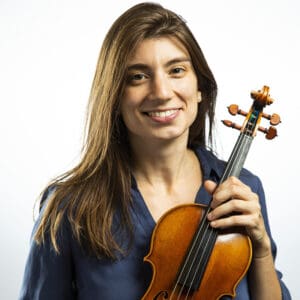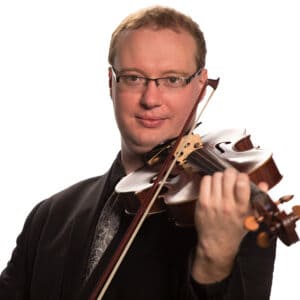September 7, 2025 / 2:30 p.m.
A stunning display of virtuosity and interplay performed by Aviva Hakanoglu, principal second violin, and Nicholas Jeffery, principal viola.
Program
Bologne
Symphony No.1 in G major 14’
Still
Mother and Child
Mozart
Sinfonia Concertante in E flat, K. 364 (Aviva Hakanoglu and Nicholas Jeffery)
Program Notes
Symphony No. 1 in G major, Op. 11
JOSEPH BOLOGNE, CHEVALIER DE SAINT-GEORGES
Born: December 25, 1745, Baillif, Guadeloupe
Died: June 10, 1799, Paris, France
Composed: Circa 1779
Premiered: 1779, Paris
Duration: 13 minutes
Joseph Bologne, Chevalier de Saint-Georges, was a remarkable figure of the 18th century—a virtuoso violinist, accomplished composer, champion fencer, and military officer. Born on Christmas Day to a French plantation owner and an enslaved African woman in the French colony of Guadeloupe, Bologne rose to prominence in Parisian society, becoming a celebrated musician and conductor. His Symphony No. 1 in G major, Op. 11, composed around 1779, exemplifies his mastery of the Classical style and his unique artistic voice.
Symphony No. 1 unfolds in three movements, each reflecting Bologne’s elegant and spirited compositional approach. Symphony No. 1, along with his Symphony No. 2, are considered perfect examples of the classical symphony and its characteristics.
The opening movement is a lively allegro and is characterized by its animated theme and style. The second movement offers a contrasting mood with its serene and lyrical character; however, one can note that despite this change in character, the sense of whimsy and lightheartedness is a constant. The Final movement picks up the tempo with a bit of back and forth between the first and second violins. This culminates in a finale where the horns drive the work to its exultant conclusion.
Bologne’s Symphony No. 1 in G major stands as a testament to his artistic prowess and his ability to navigate and contribute to the musical traditions of his time. Though the influence of Haydn is palpable, Bologne’s voice remains distinct — playful, poised, and always elegant. Through his many wonderful works, Bologne has not only affirmed his place among the leading composers of the Classical era but also left a lasting legacy that continues to inspire and captivate audiences today.
Mother and Child
WILLIAM GRANT STILL
Born: May 11, 1895, Woodville, Mississippi
Died: December 3, 1978, Los Angeles, California
Composed: 1943
Premiered: March 12, 1944, Jordan Hall, Boston
Duration: 7 minutes
William Grant Still, often hailed as the “Dean of African American Composers,” crafted Mother and Child as the second movement of his 1943 Suite for Violin and Piano. The suite pays homage to three Black visual artists, with Mother and Child drawing inspiration from a chalk drawing of the same name by Sargent Claude Johnson. The artwork portrays a young Black woman tenderly cradling her child, rendered in chalk with soft, rounded lines that convey both strength and vulnerability. Still sought to musically encapsulate the emotional depth and simplicity of Johnson’s depiction, translating visual art into this lyrical work.
Composed during a tumultuous period in Still’s life, Mother and Child emerged after he declined a lucrative film commission for Stormy Weather, objecting to its demeaning portrayal of Black individuals. This decision underscored his commitment to dignity and artistic integrity in the face of personal and professional challenges. Even so, Still channeled his experiences into compositions that celebrated Black culture and humanity without compromising on his morals.
The piece begins with a warm, flowing melody that carries the listener through a tranquil, song-like meditation. Listeners can note how Still’s harmonic language is understated yet unwaveringly expressive. There is no excess here—just clarity of line and an intimate emotional directness. Though rooted in classical tradition, the piece is imbued with elements of African American spirituals and blues, not through overt quotation, but in its melodic contours and harmonic subtleties.
Today, Mother and Child continues to captivate audiences with its heartfelt expression and elegant craftsmanship, remaining one of Still’s most performed works. It serves not only as a beautiful musical work but also as a cultural artifact that honors the intersection of visual art, music, and the African American experience.
Sinfonia Concertante in E-flat major, K. 364
WOLFGANG AMADEUS MOZART
Born: January 27, 1756, Salzburg, Austria
Died: December 5, 1791, Vienna, Austria
Composed: 1779
Premiered: Likely 1779, Salzburg
Duration: 30 minutes
Mozart’s Sinfonia Concertante in E-flat major, K. 364, stands as a masterful synthesis of symphonic grandeur and concerto virtuosity. Composed in 1779 upon his return to Salzburg from a formative tour through Mannheim and Paris, the work reflects the young composer’s exposure to the sinfonia concertante, which was particularly popular in those cities at the time. As is typical of Mozart, though, he refined and elevated the form, creating a work that rises to a different level of proficiency.
Scored for solo violin and viola, accompanied by oboes, horns, and strings, the piece treats both solo instruments as equals—engaged in a dialogue that is by turns cooperative, competitive, and conversational. Mozart enhances this interplay with a unique twist: he instructs the solo violist to tune the instrument a half-step higher than normal (scordatura), allowing it to project more brightly and match the violin’s timbre more closely. The result is a duet of remarkable balance and resonance, with the viola stepping into a more prominent role than typically afforded in Classical orchestration.
Structured in three movements, the Sinfonia Concertante opens with an Allegro maestoso in E-flat major that exudes confidence and vitality. The orchestra introduces a spirited theme, and then the soloists enter into a harmonious dialogue. The second movement, Andante, shifts the tonality to a minor key, offering a poignant, operatic lament where the violin and viola exchange expressive, intertwining lines. The final movement, Presto, returns to E-flat major, delivering a jubilant and energetic conclusion that showcases the soloists’ technical prowess within a spirited orchestral framework.
Far more than a showcase for virtuosity, the Sinfonia Concertante is a conversation across the orchestra, a celebration of musical camaraderie, and a striking example of Mozart’s gift for marrying formal innovation with human expression. It remains one of his most beloved orchestral works and a cornerstone of the repertoire for violin and viola.
About Aviva Hakanoglu

Aviva Hakanoglu pursues a multifaceted career as a performer and educator. A violinist with the Euclid Quartet, she is a full-time Lecturer at Indiana University South Bend, where the quartet is in residence. Beyond local performances and educational outreach, the quartet tours nationally and frequently records. Aviva directs the Louise E. Addicott Summer Chamber Music Festival, a ten-day event founded by the Euclid Quartet at IU South Bend.
Aviva has built a distinguished and active orchestral career. She is the principal second violin of the South Bend Symphony and has previously held roles in the Terre Haute and Owensboro Symphonies.
Aviva continually seeks innovative ways to share music with her community. She organizes concerts across Michiana, including at the Civil Rights Heritage Center and the St. Joseph County Public Library. Previously, Aviva was assistant director of the Three Village Chamber Players, a chamber music ensemble that offers free concerts and educational events on Long Island.
Aviva earned her Doctor of Musical Arts from Stony Brook University and her Master of Music from the Indiana University Jacobs School of Music. She holds a Bachelor of Arts in Philosophy and Music from Harvard. Her mentors include Jennifer Frautschi, Philip Setzer, Simin Ganatra, the Pacifica Quartet, and the Emerson Quartet.
About Nicholas Jeffery

Nicholas Jeffery is a violist and educator based in Kalamazoo, Michigan. He holds degrees from the University of Cincinnati College-Conservatory of Music, where he studied with Catherine Carroll and Masao Kawasaki, and from the University of Wisconsin-Madison, where he trained under Sally Chisholm. As a performer, Dr. Jeffery has played with the Madison Symphony Orchestra and was Principal Viola for the Illinois Symphony Orchestra. An active chamber musician, Dr. Jeffery co-founded the Ursa Ensemble, a mixed chamber group in Chicago, and has appeared as a guest artist with the Willy Street Chamber Players and the Heart Strings Ensemble in Madison, Wisconsin.
Dr. Jeffery is deeply committed to teaching and maintains a full roster of private students at the Crescendo Academy of Music. While with the Hunt String Quartet at the University of Wisconsin, he visited local elementary schools to deliver music lessons and perform in classrooms. He currently serves as Principal Viola of the South Bend Symphony Orchestra and as Assistant Principal at the Kalamazoo Symphony, where he also performs with the Burdick-Thorne String Quartet.
Click Here to Meet Our Musicians!
Sponsors

